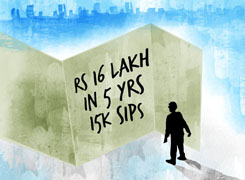Hello Sir, Hope this mail finds you well ! I am a salaried person and in the high tax bracket. I have few STPs from debt fund to Equity fund. However I find that the STPs are incurring a STCG tax and need to report in my ITR. Since I am saving for my children, I plan to start STPs directly in the name of my 2 minor daughters (aged 13 & 7 yrs, they have their individual PAN / Aadhaar card/Bank Account) with my wife as guardian (she has no personal income). Will these help me avoid the STCG tax ?If I wish to continue the STP for 5-10 yrs, will Arbritage fund be better option (since it is more tax efficient) or there is some other debt fund which I can use for monthly STP into Equity fund of my minor children ? What are the advantages and disadvantages of this strategy. Please advise. Thanks.
Ans: You have asked a very thoughtful and important question.
It’s clear that you are planning with clarity and foresight.
Starting STPs for your children’s goals with tax awareness is a smart step.
Your strategy needs to be reviewed carefully from tax, structure, control, and efficiency angles.
Let’s look at it from all sides. Below is a detailed 360-degree perspective to guide you.
? Tax on STPs from Debt to Equity Fund
– STPs are treated as systematic redemption from the source fund.
– If you are using a debt fund for STP, each unit gets redeemed monthly.
– Every redemption triggers capital gain, even if automated via STP.
– As per latest rule, any capital gain from debt fund—short or long—is taxed as per slab.
– Since you are in high tax bracket, every monthly STP triggers income-taxable gain.
– Yes, this is inconvenient. But it’s how taxation works under the new rule.
? Setting Up Investments in Minor Daughters’ Name
– Children’s names in investments offer emotional attachment and tracking clarity.
– But taxation of minor’s income doesn’t work like adult income.
– As per clubbing provisions, a minor child’s income gets clubbed with parent’s income.
– If wife has no income, gains from minors' funds will be clubbed with your income.
– Even if your wife is the guardian, the income is still taxable in your hands.
– Hence, just naming the STPs in child’s PAN doesn’t remove your tax burden.
– Tax authorities look at source of funds, not just the name on the folio.
– The only exemption: if the income is from skill or talent of the minor. This doesn’t apply here.
– Therefore, this strategy won’t help you avoid STCG or slab-level tax.
? Should You Still Invest in Children’s Name?
– Yes, you can continue investing in their names for discipline and tracking.
– It will build a dedicated fund for each child’s education or marriage.
– But do not expect tax savings from it.
– You can also assign a separate folio in your own name for each child’s goal.
– That will simplify control and tax reporting for you.
– Ultimately, it’s about mental clarity, not legal tax separation.
? Arbitrage Funds as STP Source: Tax Perspective
– Arbitrage funds are equity-oriented.
– They buy and sell same stocks in different markets.
– These funds get equity tax treatment, not debt.
– So, gains after 1 year are long-term and taxed at 12.5% above Rs 1.25 lakh.
– Short-term gains (within 12 months) taxed at 20%.
– Since STPs happen monthly, each redemption is short-term in nature.
– So arbitrage STP will attract 20% STCG for the first 12 months.
– If the gain is small each month, actual tax may be minimal.
– Still, STCG is unavoidable if STP period is less than 1 year.
? Pros of Arbitrage Funds for STP
– Taxed like equity, which is lower than debt slab tax if held >1 year.
– More stable than equity, less volatile than hybrid funds.
– Gives slightly better post-tax return than savings account.
– Can act as a semi-liquid park for short-to-medium term.
– Ideal if STP is expected to last over 12 months.
– Arbitrage strategy is lower risk compared to other equity funds.
? Cons of Arbitrage Funds for STP
– Returns are not fixed. They vary between 4% to 6% generally.
– During low market volatility, even 3.5% returns happen.
– Not suitable for goals that need predictable capital.
– Returns may not beat inflation consistently.
– Redemption within 12 months means 20% tax on gains.
– Not completely tax-free as assumed by many.
? Is Arbitrage Better Than Liquid or Debt Funds for STP?
– It depends on STP period and tax bracket.
– In your case, high tax bracket makes debt fund less efficient.
– Arbitrage may offer better post-tax outcome for STPs over 12+ months.
– For STPs under 6 months, liquid funds give safety and predictability.
– Hybrid conservative funds offer balance but carry some volatility.
– There is no one-size-fits-all. Period, goal, and tax impact must be checked.
? STP vs Lump Sum: For Long-Term Goals
– STP is great when you have lump sum ready but want to reduce equity risk.
– It reduces timing risk of equity market entry.
– Useful when investing for child’s future, wedding, or college goals.
– But each STP leg still creates taxable transaction from source fund.
– If your holding period of source fund is long, tax gets lower.
– But if STP is short and frequent, tax gets reported every time.
? How to Manage STP Tax with Less Stress
– Choose source fund as equity-oriented hybrid fund, if tax is concern.
– Or use arbitrage fund if STP is for 12+ months.
– Make sure gains stay below Rs 1.25 lakh annually to avoid LTCG tax.
– Keep STP value per month moderate.
– Avoid creating multiple STPs from multiple source funds.
– File capital gain report from CAMS/KFintech every year for ITR.
– Maintain a spreadsheet to track monthly redemptions and capital gain.
– Plan STPs to align with ITR deadlines to reduce pressure.
? Use Regular Funds Through CFP-Associated MFD
– Direct plans don’t give handholding. Mistakes can be costly over years.
– Regular funds allow Certified Financial Planners to monitor and guide.
– Fund selection, asset allocation, and tax tracking becomes easier.
– You also avoid the stress of chasing returns or timing markets.
– Regular plans come with expert insights. They’re ideal for goal-based STPs.
– Especially helpful when you have minor children and long-term goals.
– Taxation, fund switch, and rebalancing needs a reliable guide.
– Choose someone with CFP credential to stay informed and aligned.
? Why Not Index Funds or ETFs for STP Target?
– Index funds do not adapt during market corrections.
– STP to index funds may not give downside protection.
– Index funds are passive and don’t manage volatility.
– Active funds with professional management adjust to changing economy.
– Active equity mutual funds suit child goals better than index funds.
– Especially when horizon is 5–10 years or more.
– ETFs also have liquidity and tracking error issues.
– Don’t use passive funds for planned goals unless supported by solid advisory.
? Better Alternatives for STP Source Fund
– Arbitrage funds: Suitable if 12+ months STP horizon is fixed.
– Ultra short duration funds: If you prefer safety over tax-efficiency.
– Conservative hybrid funds: Moderate growth, better taxation if equity heavy.
– Liquid funds: Good for 3–6 month STP where capital must stay intact.
– Choose fund based on child goal timeline, not only on tax.
? Strategic Suggestions for Your Children’s Plan
– Maintain separate SIP or STP for each child’s goal.
– Name folios clearly for tracking – “Daughter Edu 2032”, etc.
– Don’t combine funds. Keep child-wise goals separate.
– Avoid using these folios for any other personal expense.
– Review every 12 months and adjust STP amount as needed.
– Continue investing even if market fluctuates. Child’s future is priority.
– Don’t try to time the market using STP. Stick to system.
? Finally
– STP is a smart tool. But it doesn’t avoid tax.
– Investing in minor daughter’s name won’t reduce STCG burden.
– Arbitrage fund helps if you plan for 12+ months.
– Clubbing provision nullifies tax-saving intention in minor folios.
– Use STP mainly for risk reduction, not tax saving.
– Tax will happen, but can be managed smartly with proper fund choice.
– Maintain discipline, review yearly, and always align with your goal.
– With a Certified Financial Planner, your long-term strategy will stay efficient and stress-free.
Best Regards,
K. Ramalingam, MBA, CFP,
Chief Financial Planner,
www.holisticinvestment.in
https://www.youtube.com/@HolisticInvestment





















